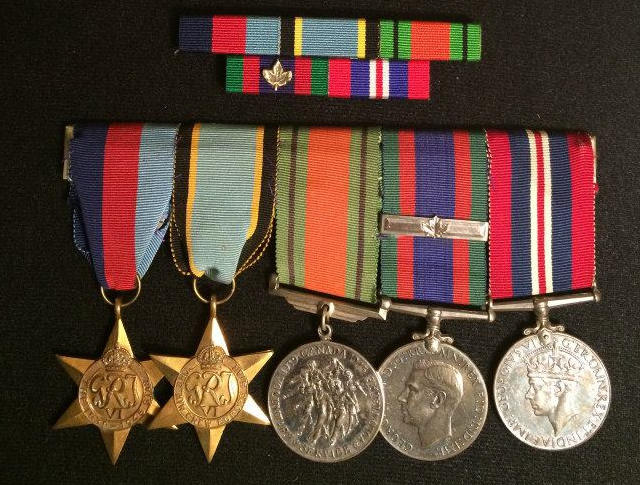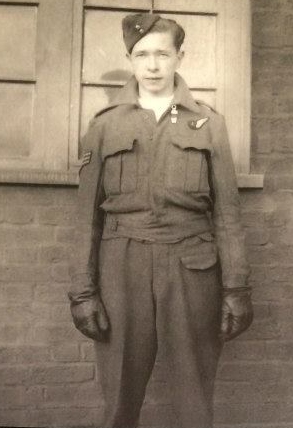Sgt. Foster is the first RCAF Flight Engineer I have so far come across. Normally during the early part of 1943 the 419
Squadron's F/E were from the RAF.
The RCAF did train their own Flight Engineers later on towards the end of 1944.
From family recollections he was at first trained in one of the ground crew trades, most likely as an Aero Mechanic. During this time he along with many others in his trade were given the chance to re-muster as aircrew in the F/E trade. Many jumped at the chance to become aircrew, Victor Foster was one of them.
The twenty year old Sgt. Victor Foster may have been posted to 419 Squadron as part of Sgt. R.S. Harrison's crew in February of 1943. (The records of the Harrison crews arrival contain many errors with initials of the crew's errors on names.)
The crew's first operation almost became their last operation when an engine failed on takeoff. The aircraft was heavy with fuel and a load of four 1,000 pound mines. Their luck held as the engine failure occurred after they had gained enough height to clear local obstructions.
The danger was still with them as the aircraft needed additional height and speed to both open the bomb doors and drop their mines safely. This first operation threw the young F/E into a situation in which he and the pilot would have practised many times prior but hoped never to use.
While Foster manned the throttle and flap controls, Harrison maneuvered the aircraft and passed on his orders to Foster. The aircraft eventually gained the needed height and speed from the work done by the F/E. Now the air speed was within a range where the drag caused by the open bomb doors would not stall the aircraft. The mines were disposed of in the SAFE mode and the crew and aircraft returned to base. One of the stories told by Foster to his family in later years was how the farmer came to the base to complain about the mines being dropped on his property and was he not on the same side.
It would be four days before the crew took on their next operation, this time to the most well defended target in their time together, Berlin.
The Harrison crew seems to have been a fluid group, on the next operation after Berlin, an operation on St. Nazaire there were several crew changes. Sgt. Foster however continued on with the Harrison crew during this operation. It would be almost a month later before the the next operation again with crew changes. Sgt. Foster would now be with a new Navigator to the crew, one well known with the squadron from earlier days,. Sgt. William Hold Ledford.
Ledford was one of the squadron's earliest Evaders, who was now returning after a period of rest following his return to Britain. Also continuing with Harrison crew with Foster was rear gunner Sgt. Eaton Morgan. Following this operation over Germany, Sgt. Foster completed one more Gardening Op with Harrison.
By the end of April Sgt. Foster was reposted and other changes occurred with the Harrison crew. The next operation saw Sgt. Eaton Morgan had also leaving the crew.
Sgt. Ledford would continue on with Harrison until June 20th. He later was posted to 434 squadron and was killed while on an operation with that squadron.
Sgt. William Eaton Morgan continued on as a Rear Gunner and was lost while operations on Lancaster KB765, during December of 1944
Sgt. William Ledford Evader
Sgt. Ledford and Wellington DF665
Sgt. William Eaton Morgan and Lancaster KB765
The RCAF did train their own Flight Engineers later on towards the end of 1944.
From family recollections he was at first trained in one of the ground crew trades, most likely as an Aero Mechanic. During this time he along with many others in his trade were given the chance to re-muster as aircrew in the F/E trade. Many jumped at the chance to become aircrew, Victor Foster was one of them.
The twenty year old Sgt. Victor Foster may have been posted to 419 Squadron as part of Sgt. R.S. Harrison's crew in February of 1943. (The records of the Harrison crews arrival contain many errors with initials of the crew's errors on names.)
The crew's first operation almost became their last operation when an engine failed on takeoff. The aircraft was heavy with fuel and a load of four 1,000 pound mines. Their luck held as the engine failure occurred after they had gained enough height to clear local obstructions.
The danger was still with them as the aircraft needed additional height and speed to both open the bomb doors and drop their mines safely. This first operation threw the young F/E into a situation in which he and the pilot would have practised many times prior but hoped never to use.
While Foster manned the throttle and flap controls, Harrison maneuvered the aircraft and passed on his orders to Foster. The aircraft eventually gained the needed height and speed from the work done by the F/E. Now the air speed was within a range where the drag caused by the open bomb doors would not stall the aircraft. The mines were disposed of in the SAFE mode and the crew and aircraft returned to base. One of the stories told by Foster to his family in later years was how the farmer came to the base to complain about the mines being dropped on his property and was he not on the same side.
More Operations over Germany and Mine Laying
It would be four days before the crew took on their next operation, this time to the most well defended target in their time together, Berlin.
The Harrison crew seems to have been a fluid group, on the next operation after Berlin, an operation on St. Nazaire there were several crew changes. Sgt. Foster however continued on with the Harrison crew during this operation. It would be almost a month later before the the next operation again with crew changes. Sgt. Foster would now be with a new Navigator to the crew, one well known with the squadron from earlier days,. Sgt. William Hold Ledford.
Ledford was one of the squadron's earliest Evaders, who was now returning after a period of rest following his return to Britain. Also continuing with Harrison crew with Foster was rear gunner Sgt. Eaton Morgan. Following this operation over Germany, Sgt. Foster completed one more Gardening Op with Harrison.
By the end of April Sgt. Foster was reposted and other changes occurred with the Harrison crew. The next operation saw Sgt. Eaton Morgan had also leaving the crew.
Sgt. Ledford would continue on with Harrison until June 20th. He later was posted to 434 squadron and was killed while on an operation with that squadron.
Sgt. William Eaton Morgan continued on as a Rear Gunner and was lost while operations on Lancaster KB765, during December of 1944
Sgt. William Ledford Evader
Sgt. Ledford and Wellington DF665
Sgt. William Eaton Morgan and Lancaster KB765

